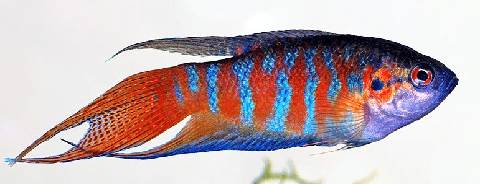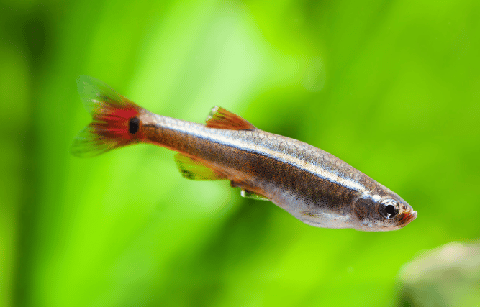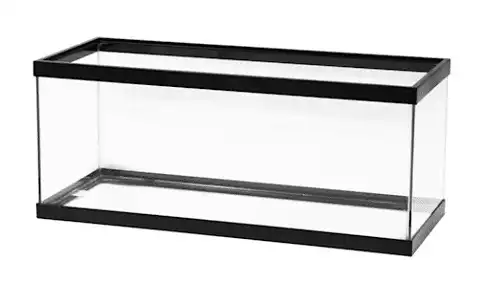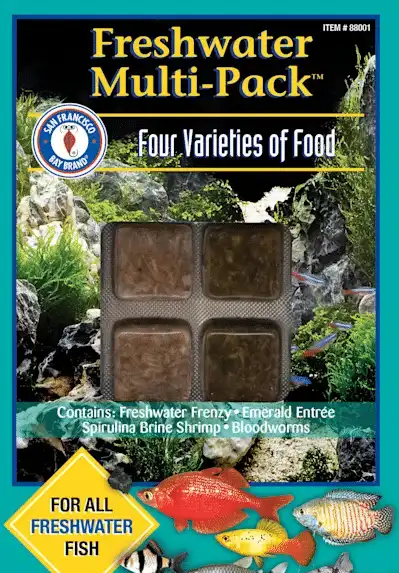Thank you for visiting! By the way… any links on this page that lead to products on Amazon and other stores/partners are affiliate links Aquarium Store Depot earns a commission if you make a purchase.
For those looking to incorporate a beautiful piece of paradise into their home aquarium, the vibrant and one-of-a-kind Paradise Fish is an ideal choice.
To help you make sure you know what this fish needs, we’ll take a look at everything from where they come from naturally, what kind of tank environment best suits them, as well as compatible tank mates. Ready to learn about the original fish that started it all? Let’s get started!
Key Takeaways
- Paradise fish need at minimum a 15 gallon tank
- Males may attack other male paradise fish and any fish that looks like them
- They prefer a meatier diet, which a preference to meaty frozen foods
- They are easy to breed and breed similar to Betta fish
Species Overview
| Scientific Name | Macropodus opercularis |
| Common Names | Paradise Fish, Paradise Gourami, Blue Paradise Fish, Chinese Fighting Fish |
| Family | Osphronemidae |
| Origin | South America, Amazon Basin |
| Diet | Omnivorous |
| Care Difficulty | Easy |
| Activity | Active |
| Life Expectancy | 8 – 10 Years |
| Temperament | Peaceful – aggressive towards fish that look like them and own kid |
| Tank Level | All |
| Minimum Tank Size | 20 gallons (75 liters) – for community tank 5 gallons if kept solo |
| Water Temperature Range | 60-74 F (16-23 C) |
| Water Hardness | 4 – 18 dKH |
| pH Range | 6.0 – 8.0 |
| Filtration/Water Flow | Moderate |
| Water Type | Freshwater |
| Breeding | Via Bubble Nest |
| Difficulty to Breed | Easy |
| Compatibility | Community thank with similar sized and temperament fish |
| OK, for Planted Tanks? | Yes |
Introduction
Macropodus opercularis, commonly known as Paradise Fish, are a species of native freshwater gourami with vibrant colors and aggressive personalities. Comparable to the Siamese fighting fish due to their combative temperament, they possess long dorsal and anal fins, which make them great centerpiece fish in a smaller aquarium!
Due to these creatures’ aggressive attitudes toward fish that look like them, it can be difficult to keep them alongside other types of aquatic life. They do best with schooling fish and fish that don’t occupy the same space as them.
This fight was the genesis of the aquarium industry in the US. Let’s learn more about its origins below.
Origins And Natural Habitat
Southeast Asia is home to Paradise Fish, wild paradise fish species that dwell in calm bodies of water with abundant plants. These fish typically inhabit rice paddies, ponds, and streams where they can hide from predators.
They are known as Chinese Fighting Fish since they were bred for fighting. A popular past time in the 19th and early 20th century was fish fighting, where these fish were used for entertainment. When this activity faded away, the fish was introduced as an ornamental fish. It was first introduced in Europe in 1969 to France. It is considered the original aquarium fish to the west. The OG for that matter.
Appearance

The Blue Paradise Fish have a unique and mesmerizing physical appearance, having an elongated body of blue mixed with reddish-orange hues. The males make quite the statement when they flare their fins to show off the colors in all their intensity during mating. For protection or warning against other fish, these fascinating creatures darken up their coloration while spreading out their fins for intimidation purposes as well. Like many other gouramis, they have a labyrinth organ that allows them to breath air from above the water.
Not only are they aesthetically captivating, but also that vibrant shade serves a purpose when courting suitable mates. Showing off those ornamental features paired with elaborate dance moves makes them very attractive indeed! This intricate behavior adds character to this amazing breed of aquatic lifeforms, adding yet another layer of fascination towards them, which can be easily spotted in any aquarium setting.
Types Of Paradise Fish
There are actually a number of Paradise fish varieties available in the hobby. First, there are two genetically engineered strains for Paradise fish. There is an albino type and a concolor, which is also known as a Black Paradise Fish.
There are also three gourami species that are commonly labeled as paradise fish, with only the first one listed here is considered the true paradise fish in the hobby:
- Macropodus Opercularis – sporting a forked tail
- Macropodus Chinensis – with a round tail
- Macropodus Cupanus – pointed tail
Lifespan
Keeping your Paradise Fish in good condition is key to ensuring a long and healthy life for them. It’s the responsibility of their keeper to create an appropriate environment with stable water conditions, nutritious meals, and reduced levels of stressors that can help these fish live between 8-10 years.
Ensuring proper water quality should always be prioritized. As it serves as the foundation on which all other efforts lay upon – diet, stress levels, etc. All those elements need to converge in order to provide a suitable habitat for these remarkable creatures!
Average Size
The Paradise Fish males, are distinguished by their longer dorsal and anal fins, are larger than female paradise fish and have brighter coloration. The average length of and adult paradise gourmai fish is around 2-3 inches, making them small fish. Thus, when setting up the tank for such fish it is important to take into consideration their potential growth as well as suitable tank mates that will provide sufficient space conducive to thriving.
Creating The Ideal Paradise Fish Tank Environment

Creating an appropriate habitat for your Paradise Fish is key to keeping them content and healthy. These fish prefer tanks that are heavily planted, resembling their natural environment, giving plenty of places to hide and explore.
So when setting up a tank for these little swimmers, one must take into account the following considerations: size of the tank, water parameters, and substrate used in base layer—and plant selection.
Tank Size And Water Parameters (Tank Conditions)
When it comes to the tank size for your Paradise Fish, a minimum of 20 gallons is advised if kept in a community tank. They can be keep in tanks as small as 5 gallons if they are kept alone. The environmental factors are just as important in keeping these resilient fish healthy. Optimal temperature levels vary from 60-74°F and pH ranges between 6-8 must also be maintained to make sure they stay happy at home.
A classic 20 gallon aquarium in its 30 inch long variant. A very popular aquarium.
They are considered a cold water fish since they can live in room temperature water. They do best in cooler water and should not require an aquarium heater. For essential water parameters, try to main these levels in your aquarium:
Substrate And Plants
When setting up a Paradise Fish tank, it is ideal to include an aquarium substrate that mimics the ground of their natural habitat. Sand can create this realistic atmosphere and act as the perfect background for them. Because they will feel better at home with sand, floating, and plants that feed off the water column are better fits. Here are a few solid choices:
You can also try Amazon Sword and Vallisneria, but you would need a planted substrate so their roots can take hold. Live plants provide a lot of benefits such as improving water quality whilst also providing protection and security for your fish.
Readily available and easy to grow. This fast growing plant will soak up nutrients and thrive in low light
Diet And Nutrition
In order to ensure the well-being of your Paradise Fish, it is important that they receive a balanced and nutritious diet. Like bettas, they are insectivores and have a short digestive system. This requires them to have a high protein diet with no fillers. This makes many types of flake food inappropriate for them as a result.
To guarantee optimal growth and coloration for your tropical fish, an appropriate variety of live or frozen foods should be offered regularly, including brine shrimp, mosquito larvae, daphnia/bloodworms, spirulina flakes & tubifex worms, etc.
They prefer meaty foods, so frozen is the best choice. You can use a freshwater variety frozen pack from SF Bay or purchase frozen bloodworms. You can also culture your own live food if you are willing to go through with that. If you are looking for a pellet option – consider fluval bug bites as it has the insect matter these fish need.
This frozen food pack contains 4 types of formulas in one package. A great overall package for freshwater fish
As we always recommend, you should keep your paradise fish diet balanced. Always switch out food regularly so you can mix up the different types of food. Mixing up foods will keep your colors in your Paradise fish bold and bright. By offering a mix of different types of fish food – fresh or frozen – you take one major step closer to ensuring ongoing health for those pets.
Feeding Schedule
It is essential to maintain a consistent feeding routine for your Paradise Fish in order to meet their nutritional needs. To ensure optimal health and vitality, you should feed them twice a day with only as much food that can be consumed within 1 minute. Extra uneaten foods should be taken out of the tank in order to preserve quality levels.
A balanced diet including live/frozen options such as brine shrimp, white worms and bloodworms are great sources of protein but also lend vibrant colors which will enrich their appearance, while pellets or flakes provide all the necessary vitamins & minerals they need in terms of healthy growth rate advancement.
For livefoods, you can cultivate blackworms or consider getting microfauna from a reliable source if you have a planted tank for a natural food source for your fish.
Choosing Compatible Tank Mates
Finding the right tank mates for your Paradise Fish can be a difficult task due to their aggressive nature. To ensure that all aquatic inhabitants have their needs met, it is essential to assess both requirements and behavior when deciding on fish species best suited for cohabitation with them. Herein, we will discuss how one should choose compatible aquarium partners for these finned animals as well as provide an overview of ideal companions and those which you should stay away from.
Ideal Tank Mates

It is important to choose larger, peaceful fish when looking for paradise fish tank mates. Suitable species include:
- Comet goldfish
- Geophagus cichlids
- Bristlenose plecos
- White Cloud Mountain Minnow
- Coldwater schooling fish like gold barbs
- Corydoras Catfish
These fish above are large enough not to get bulled and do not look like them to trigger their aggressive behavior. Even though these options are likely compatible with your paradise fish in its environment, it is vital that any interactions between them all still need close monitoring so adjustments can be made if necessary. A balanced mix of different creatures is achievable with continual assessment and an openness to making adaptations as required within the community tank.
Incompatible Species
Creating a balanced environment is key for Paradise Fish to thrive, so it’s important not to keep them with other aggressive species or slow-moving fish that have long fins. Examples, aside from the same species may include:
- Betta fish
- Larger aggressive cichlids
- Angelfish – Paradise will go after them
- Discus Fish – they require temperatures that are too warm
- Semi-aggressive barbs like tiger barbs
- Semi aggressive sharks like the red-tail shark
To ensure your pet has an ideal living space, select suitable companions such as those of its own kind, but avoid any species that might initiate aggression towards them. By doing this you will be able to form a harmonious atmosphere in which they can flourish!
When it comes to other Paradise fish, unlike Betta Fish males will only fight if kept in a pair of males. Multiple males can live together. You will need a longer tank and plenty of shelter to pull it off.
Breeding
Learning how to breed Paradise fish in an aquarium can be a very rewarding experience for any fish enthusiast. If the proper paradise fish care is provided, owners are able to witness the unique courting and spawning processes that end with new generations of dazzlingly colored fish coming into existence (video source).
Courtship And Spawning
Raising Paradise Fish in an aquarium requires careful management and attention. To start the breeding process, the male fish builds a bubble nest at the water’s surface and performs courtship dances to attract a receptive female for mating.
If accepted, they embrace their shared bubbly home and release both eggs and sperm into it so fertilization can take place. It is important that after this happens, separate them because the male will start to become aggressive to the female! The male will can guard the eggs in the bubble nest until they hatch. Once the eggs hatch, it’s time to remove the male. If you don’t remove the male after the fry arrive, they could quickly because snacks for him! With proper care, you’ll successfully raise your own population of these beautiful creatures in no time!
Common Health Problems
When it comes to other fish species, labyrinth fish like Paradise Fish can experience health issues if they are not maintained properly. These illnesses include Lymphocystis disease, which causes lumps on the fins and may reduce their ability to swim as well as fin rot or fighting caused by bacterial infections. They can also fall ill to aliments like ich and freshwater velvet.
Maintaining ideal water quality levels. To provide a balanced diet and keep stress out of the tank environment is necessary so that your Paradise Fish stay healthy. By being attentive and acting quickly on potential problems, you will guarantee these beautiful fishes remain thriving occupants of your aquarium ecosystem!
Frequently Asked Questions
Is paradise fish aggressive?
The Paradise Fish has a reputation for being aggressive and hostile towards other fish, with males particularly intense in their behavior. To ensure that no casualty occurs, one should choose fish which are either quick or large enough to get out of the way, or fish that do not look like before becoming targeted by this species. Both male and female varieties can be very combative, so size is an important factor when selecting suitable tankmates for them.
Can paradise fish live with other fish?
Yes, paradise fish can be housed with other fish. They do best with schooling fish that do not look like them. It is possible that some may share their environment with certain types of bigger creatures that don’t pose a danger to them.
Can paradise fish live with shrimp?
Although keeping paradise fish with some peaceful invertebrates can be done, there is a risk that they may hunt for dwarf shrimp and other tiny organisms.
What is the ideal tank size for Paradise Fish?
A 20 gallon tank is ideal for keeping Paradise Fish healthy and happy, as it provides the optimal care they require. Larger tanks are recommended if you want to keep other fish with them.
What should I feed my Paradise Fish?
It is important to ensure your fish get the proper nutrients, and one way of doing this is by feeding them a mixture of live foods such as bloodworms or white worms, frozen options like brine shrimp, and quality pellets/flakes. Live food can provide protein, which helps keep Paradise Fish in good health, while frozen meals are an easy-to-store solution that has a variety of nutritious benefits. Offering both types will give these aquatic animals what they need for happiness!
Closing Thoughts
In summary, the amazing coloring and behaviors of Paradise Gouramis make them a highly sought-after addition to any home aquarium. While they can present difficulties for new aquarists due to their feisty character and specific requirements, it is possible to successfully keep this species with attentive care that provides suitable environments, diets & compatible tank mates.
This guide has been designed in order to offer you all the information needed so that you may confidently take ownership of these truly remarkable creatures and create your own unique ecosystem showcasing them at their very best! We hope you learned a few things and got value out of this post.
Do you have a paradise fish? Let us know in the comments about your experience with them. We love to hear from our readers. Until next time!
- About the Author
- Latest Posts
I’m thrilled that you found Aquarium Store Depot! Here you’ll find information on fish, aquariums, and all things aquatics related. I’m a hobbyist (being doing this since I was 11) and here to help other hobbyists thrive with their aquariums! I adhere to a high quality Editorial Process and Review products with real life field usage and practical analysis.







